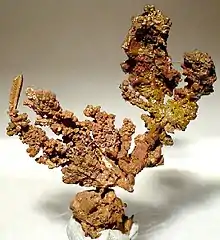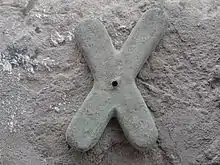Copperbelt
The Copperbelt is a natural region in Central Africa which sits on the border region between northern Zambia and the southern Democratic Republic of Congo. It is known for copper mining.


Traditionally, the term Copperbelt includes the mining regions of Zambia's Copperbelt Province (notably the towns of Ndola, Kitwe, Chingola, Luanshya, and Mufulira in particular) and the Congo's Haut-Katanga and Lualaba provinces (notably Lubumbashi, Kolwezi, and Likasi). In some contexts the term may exclude the Congo entirely.
History



The Western discovery of copper in Zambia is partly due to American scout Frederick Russell Burnham. In 1895 he led the Northern Territories (BSA) Exploration Co. expedition, which determined that major copper deposits existed in Central Africa.[1] Along the Kafue River in then Northern Rhodesia, Burnham saw many similarities to copper deposits he had worked in the United States, and he encountered natives wearing copper bracelets.[2] In his report to the British South Africa Company Burnham said about the region:[3]
About 200 miles north of the Falls on the Incalla river, and twelve miles from the Kafukwe (Ed: now known as the Kafue River) and still on the high plateau is probably one of the greatest copper fields on the continent. The natives have worked this ore for ages, as can be seen by their old dumps, and they work it to-day. The field is very extensive, and reaches away to Katanga... The natives inhabiting this part of the country are skilled workmen, and have traded their handiwork with all comers, even as far afield as the Portuguese of the West Coast and the Arabs of the East. These natives, being miners and workers of copper and iron, and being permanently located in the ground, would give the very element needed in developing these fields.
The increasing use of copper bids fair to make it one of the most valuable products a country can have.... The copper mines of Montana and Arizona have proven of more value than the gold mines, regardless of the fact that the copper had to be hauled two thousand miles by rail to the seaboard, and the coal and coke to smelt it hauled hundreds of miles to the mines. So far as natural difficulties are concerned, this northern field can be fed from the coal deposits of the valley of the Zambezi (Ed: Burnham had previously discovered the massive coal fields at Hwange), and the product shipped to the East Coast at a less expense than the product of Montana and Arizona can be laid on the dock at New York.
Many years later, the British South Africa Company built towns along the river and a railroad to transport the copper through Mozambique.[4]
Prehistory
The Copperbelt was inhabited by many prehistoric groups including the Chondwe Group whose pottery resembles that of Luangwa vessels found today in the Kalambo Falls region.[5]
Geology
During the 1950s, this was the largest copper producing area in the world, and included the Roan Antelope Mine, Nkana Mine, the Nchanga Mines, the Mufulira Mine, and the Rokana Mine. Chalcopyrite, bornite, and chalcocite are found in the metamorphosed calcareous shales and arkoses of the Lower Roan Formation in the Katanga System.[6]
Popular Culture
From Doris Lessing's The Grass is Singing, "He met a man from Northern Rhodesia, who told him about the copper mines and the wonderfully high salaries. They sounded fantastic to Tony, He took the next train to the copper belt..."[7]
See also
References
- Baxter, T.W.; E.E. Burke (1970). Guide to the Historical Manuscripts in the National Archives of Rhodesia. p. 67.
- Burnham, Frederick Russell (1926). Scouting on Two Continents. Doubleday, Page & company. pp. 2, Chapters 3 & 4. OCLC 407686.
- Burnham, Frederick Russell (1899). "Northern Rhodesia". In Wills, Walter H. (ed.). . Simpkin, Marshall, Hamilton, Kent & Co. pp. 177–180.
- Juang, Richard M. (2008). Africa and the Americas: culture, politics, and history : a multidisciplinary encyclopedia, Volume 2 Transatlantic relations series. ABC-CLIO. p. 1157. ISBN 1-85109-441-5.
- Phillipson, D.W. (1974). "Iron Age History and Archaeology in Zambia". The Journal of African History. 15 (1): 1–25. doi:10.1017/s0021853700013219. JSTOR 180367.
- Heinrich, E. Wm. (1958). Mineralogy and Geology of Radioactive Raw Materials. New York: McGraw-Hill Book COmpany, Inc. p. 298.
- Lessing, Doris (1950). The Grass is Singing. New York: Harper Perennial. p. 25. ISBN 9780061673740.
External links
| Wikimedia Commons has media related to |
